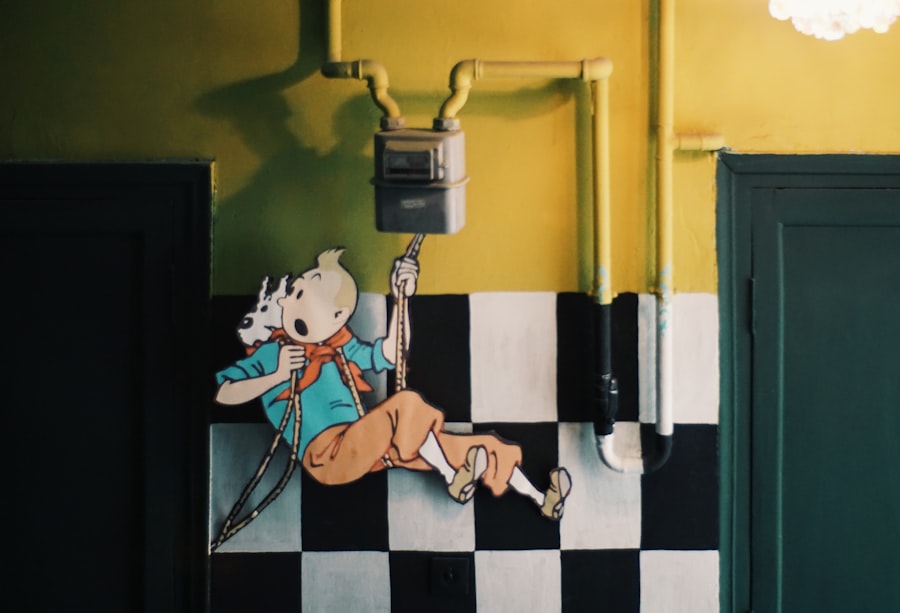The tale of Pinocchio, a wooden puppet brought to life, is steeped in rich symbolism and moral lessons. At the heart of this narrative lies the origin of Pinocchio’s conscience, which is personified by the character of the Talking Cricket. This cricket serves as a moral compass for Pinocchio, guiding him through the complexities of right and wrong.
The origins of this conscience can be traced back to the very essence of what it means to be human. In many ways, the Talking Cricket embodies the innate sense of morality that exists within all individuals, urging them to make choices that reflect their true character. In the story, the Talking Cricket appears as a wise and gentle figure, representing the voice of reason that often goes unheard in the face of temptation.
His presence signifies the internal struggle that Pinocchio faces as he navigates a world filled with distractions and moral dilemmas. The cricket’s role is not merely to chastise Pinocchio for his misdeeds but to encourage him to reflect on his actions and their consequences. This dynamic sets the stage for a profound exploration of conscience, illustrating how it can guide individuals toward personal growth and self-awareness.
Key Takeaways
- Pinocchio’s conscience originated from the talking cricket, who served as his moral guide.
- The talking cricket played a crucial role in advising and guiding Pinocchio throughout his journey.
- Despite the talking cricket’s advice, Pinocchio often disregarded it, leading to dire consequences.
- The talking cricket made numerous attempts to steer Pinocchio in the right direction, but to no avail.
- Pinocchio’s decision to confront the talking cricket resulted in tragic consequences and deep regret.
The Role of the Talking Cricket in Pinocchio’s Story
The Talking Cricket plays a pivotal role in Pinocchio’s journey, serving as both a mentor and a moral guide. From the moment he enters the story, the cricket’s wisdom becomes apparent, as he attempts to steer Pinocchio away from the pitfalls of dishonesty and recklessness. His character is imbued with a sense of authority that stems from his experience and understanding of the world.
As Pinocchio embarks on his adventures, the cricket’s guidance becomes increasingly crucial, highlighting the importance of having a reliable source of wisdom in one’s life. Moreover, the Talking Cricket represents the voice of conscience that often goes unheeded in moments of temptation. His attempts to communicate with Pinocchio serve as a reminder that individuals must listen to their inner voice, even when it is difficult to do so.
The cricket’s unwavering commitment to guiding Pinocchio underscores the theme of personal responsibility, emphasizing that one must take ownership of their choices and learn from their mistakes. Through his interactions with Pinocchio, the Talking Cricket embodies the struggle between temptation and virtue, illustrating the challenges that come with growing up and making moral decisions.
Pinocchio’s Disregard for the Talking Cricket’s Advice

Despite the Talking Cricket’s earnest attempts to guide him, Pinocchio often disregards his advice, choosing instead to follow his whims and desires. This disregard for wisdom reflects a common human tendency to prioritize immediate gratification over long-term consequences. Pinocchio’s impulsive nature leads him down a path filled with mischief and trouble, as he succumbs to the allure of adventure without considering the potential repercussions.
His actions serve as a cautionary tale about the dangers of ignoring one’s conscience in favor of fleeting pleasures. Pinocchio’s defiance towards the Talking Cricket also highlights a critical aspect of his character development. Initially, he views the cricket’s guidance as an annoyance rather than a valuable resource.
This attitude illustrates a lack of maturity and understanding, as he fails to recognize that true growth often comes from listening to those who have more experience. The tension between Pinocchio and the Talking Cricket serves as a microcosm of the broader struggle between youthful impulsiveness and the wisdom that comes with age and experience.
The Talking Cricket’s Attempts to Guide Pinocchio
| Chapter | Event | Outcome |
|---|---|---|
| Chapter 4 | The Talking Cricket advises Pinocchio to go home | Pinocchio ignores the advice and gets into trouble |
| Chapter 8 | The Talking Cricket warns Pinocchio about the dangers of Pleasure Island | Pinocchio ignores the warning and ends up in trouble again |
| Chapter 15 | The Talking Cricket advises Pinocchio to be good and obedient | Pinocchio finally listens and starts to change his behavior |
Throughout the story, the Talking Cricket makes numerous attempts to guide Pinocchio toward making better choices. He offers sage advice, urging Pinocchio to embrace honesty and integrity as foundational values. The cricket’s words are often laced with gentle reminders about the importance of responsibility and accountability.
Despite his best efforts, however, Pinocchio remains resistant, often dismissing the cricket’s counsel in favor of his own desires. The cricket’s persistence in trying to reach Pinocchio speaks volumes about his character. He embodies patience and compassion, understanding that growth is not always linear and that individuals may need time to learn from their mistakes.
Each interaction between them serves as an opportunity for Pinocchio to reflect on his choices, even if he does not immediately recognize their significance. The Talking Cricket’s unwavering commitment to guiding Pinocchio illustrates the importance of mentorship and support in one’s journey toward self-discovery.
Pinocchio’s Fateful Decision to Confront the Talking Cricket
In a moment of frustration and defiance, Pinocchio makes a fateful decision to confront the Talking Cricket. This confrontation marks a turning point in their relationship, as it symbolizes Pinocchio’s rejection of guidance and wisdom. Fueled by youthful arrogance, he believes he knows better than the cricket, dismissing his advice as irrelevant.
This pivotal moment encapsulates the struggle between youthful bravado and the humility required for personal growth. The confrontation also serves as a reflection of Pinocchio’s internal conflict. On one hand, he yearns for freedom and adventure; on the other hand, he grapples with the consequences of his choices.
By confronting the Talking Cricket, Pinocchio is not only rejecting external guidance but also denying an essential part of himself—the voice of conscience that seeks to steer him toward righteousness. This decision ultimately sets in motion a series of events that will have profound implications for both characters.
The Consequences of Pinocchio’s Confrontation

The consequences of Pinocchio’s confrontation with the Talking Cricket are immediate and severe. In his moment of anger, he dismisses the cricket’s wisdom entirely, leading to a tragic outcome that reverberates throughout the story. The cricket’s fate serves as a stark reminder of what can happen when one chooses to ignore their conscience and reject guidance from those who care about them.
This moment becomes a catalyst for change in Pinocchio’s life, forcing him to confront the reality of his choices. As Pinocchio grapples with the aftermath of his actions, he begins to understand that every decision carries weight and significance. The loss of the Talking Cricket leaves a void in his life—a void that symbolizes not only the absence of guidance but also the consequences of his own recklessness.
This turning point serves as a powerful lesson about accountability and responsibility, illustrating how one’s actions can have far-reaching effects on others.
Pinocchio’s Regret and Guilt Over the Talking Cricket’s Fate
In the wake of his confrontation with the Talking Cricket, Pinocchio is consumed by feelings of regret and guilt. The realization that he has lost a valuable source of wisdom weighs heavily on him, forcing him to confront the reality of his choices. This emotional turmoil marks a significant shift in Pinocchio’s character; he begins to understand that true growth often comes from acknowledging one’s mistakes and taking responsibility for them.
As he reflects on his actions, Pinocchio grapples with feelings of sorrow for having dismissed someone who genuinely cared for him. The absence of the Talking Cricket serves as a constant reminder of what he has lost—a guiding light that could have steered him away from danger. This period of introspection becomes crucial for Pinocchio’s development, as it lays the groundwork for his eventual redemption and growth.
The Moral Lesson of Pinocchio’s Deadly Confrontation
The moral lesson stemming from Pinocchio’s deadly confrontation with the Talking Cricket is profound and multifaceted. At its core, it emphasizes the importance of listening to one’s conscience and valuing guidance from those who possess wisdom and experience. The story illustrates how ignoring this inner voice can lead to dire consequences—not just for oneself but also for others who may be affected by one’s choices.
Furthermore, this confrontation serves as a cautionary tale about pride and arrogance. Pinocchio’s belief that he knows better than those who seek to guide him ultimately leads to tragedy. The narrative underscores that true strength lies not in defiance but in humility—the ability to recognize one’s limitations and seek help when needed.
This moral lesson resonates deeply with readers, reminding them that personal growth often requires vulnerability and openness to change.
The Impact of the Talking Cricket’s Absence on Pinocchio’s Journey
The absence of the Talking Cricket profoundly impacts Pinocchio’s journey toward self-discovery and redemption. Without this guiding presence, he finds himself adrift in a world filled with temptations and moral dilemmas. The loss serves as a stark reminder of how crucial it is to have mentors or figures who can provide guidance during challenging times.
As he navigates through various trials and tribulations, Pinocchio begins to realize just how much he relied on the cricket’s wisdom. This absence also forces Pinocchio to confront his own shortcomings more directly. He must grapple with decisions without external guidance, leading him to develop a deeper understanding of himself and his values.
The journey becomes one of self-reflection and growth; he learns that while external guidance is invaluable, true wisdom must ultimately come from within. This realization marks a significant step in his transformation from a reckless puppet into a more thoughtful and responsible individual.
Pinocchio’s Redemption and Growth Following the Tragic Event
In the aftermath of losing the Talking Cricket, Pinocchio embarks on a path toward redemption and personal growth. The weight of guilt propels him to reevaluate his choices and strive for change. He begins to understand that true freedom comes not from reckless abandon but from making responsible decisions aligned with one’s values.
This newfound perspective marks a turning point in his character development; he starts taking ownership of his actions rather than blaming external circumstances. As he navigates through challenges without his cricket companion, Pinocchio learns valuable lessons about honesty, integrity, and compassion.
Through this journey toward redemption, Pinocchio transforms into a more mature individual who understands that true fulfillment comes from living authentically and embracing one’s responsibilities.
The Legacy of the Talking Cricket in Pinocchio’s Tale
The legacy of the Talking Cricket endures throughout Pinocchio’s tale, serving as a poignant reminder of the importance of conscience and moral guidance in one’s life. Even after his tragic fate, the lessons imparted by the cricket continue to resonate within Pinocchio as he navigates his journey toward redemption. The cricket’s wisdom becomes an integral part of Pinocchio’s character development; it shapes his understanding of right and wrong long after their physical separation.
Moreover, the Talking Cricket symbolizes hope—the idea that even in moments of darkness and regret, there exists an opportunity for growth and change. His legacy encourages readers to reflect on their own lives and consider how they can cultivate their inner voice while valuing guidance from others. Ultimately, through its exploration of conscience, morality, and personal growth, Pinocchio’s tale leaves an indelible mark on its audience—reminding them that every choice carries weight and significance in shaping one’s destiny.
In the dark retelling of the classic tale, “Pinocchio Kills the Talking Cricket,” the story takes a sinister turn as the beloved wooden puppet grapples with his conscience and the consequences of his actions. This theme of moral conflict is echoed in another intriguing article that explores the deeper meanings behind fairy tales and their adaptations. For more insights, you can read about it in this related article.
WATCH THIS! The Pinocchio Story Disney Doesn’t Want You To Know (It’s Brutal)
FAQs
What is the story of Pinocchio?
The story of Pinocchio is a classic Italian children’s novel written by Carlo Collodi. It follows the adventures of a wooden puppet named Pinocchio who dreams of becoming a real boy. Throughout the story, Pinocchio encounters various characters and learns valuable life lessons.
Who is the talking cricket in Pinocchio?
The talking cricket, also known as the Cricket or the Talking Cricket, is a character in the story of Pinocchio. He serves as a moral guide and conscience for Pinocchio, offering advice and warnings throughout the story.
How does Pinocchio kill the talking cricket?
In the original story, Pinocchio kills the talking cricket by throwing a mallet at him in a fit of rage. This action sets off a chain of events that leads to consequences for Pinocchio.
What is the significance of the talking cricket in the story?
The talking cricket serves as a moral compass for Pinocchio, offering guidance and advice. His death at the hands of Pinocchio symbolizes the puppet’s disregard for authority and consequences, setting the stage for his journey of self-discovery and redemption.
What lessons can be learned from the story of Pinocchio?
The story of Pinocchio teaches valuable lessons about honesty, integrity, and the consequences of one’s actions. It emphasizes the importance of listening to one’s conscience and making choices that align with moral values.
